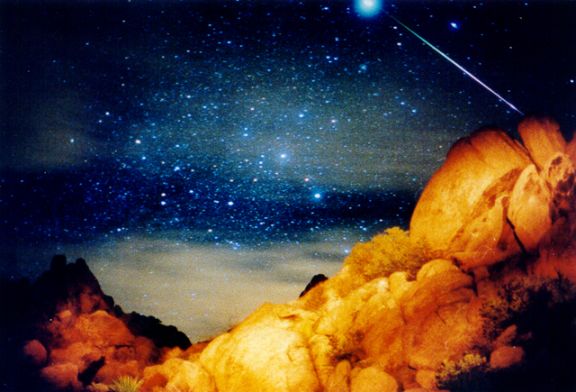This is how the world will end: with a quiet bit of news on the BBC.
I got home from work last night to find out, incredibly, that “[h]undreds of people in Peru have needed treatment after an object from space – said to be a meteorite – plummeted to Earth in a remote area.”
 [Image: A spectacular glimpse of the Leonid meteor shower, circa 1999; photo by Wally Pacholka].
[Image: A spectacular glimpse of the Leonid meteor shower, circa 1999; photo by Wally Pacholka].
The object “left a deep crater” that immediately began “spewing fetid gases,” and everyone who has “visited the scene” has since “been complaining of headaches, vomiting and nausea.”
A local villager, worried for himself and for his neighbors, says: “We don’t know what is going on at the moment, that is what we are worried about.”
It’s a virus from space!
So I half-seriously expected to wake up this morning and read that the entire population of Peru has been wiped out by clouds of alien zombie-dust; that militaries have been mobilized; that families are now scrambling in all possible directions to find a safety that will no longer come; and that the catastrophe continues to spread… In eight days’ time it reaches the streets of San Francisco, where I’ll be live-blogging the outbreak from behind a plywood barricade.
But it turns out that we don’t need to worry after all: the scientists quoted in the original article are right.
It wasn’t an object from space at all but “a fireball,” the appearance of which led people to hike out into the wild and find “a lake of sedimentary deposit, which may be full of smelly, methane rich organic matter.”
This “rich organic matter” made everyone ill – infected by rot and vegetation. It’s a kind of petro-illness.
Hey Geoff,
Amazing story. This is unrelated, but I just published a long post on architecture as high-art subject matter and would love to hear your thoughts on it if you have a moment (though I understand you probably don’t). Thanks either way and keep up the amazing writing.
Just swamp gas — is that what they’re saying now? And you’re buying it? Or did the alien bran parasites get to you, too? Here’s the truth, Geoff.
Hi Geoff,
Following on from the giant mastaba that I told you about the other day, I now hear that the UAE are planning to buy a solar island. These guys are clearly way ahead of the rest of us when it comes to large structures (not to mention buildings!)
Cheers,
Earle.
Hello,
We would like to do an interview with you about your blog for
http://www.BlogInterviewer.com . We’d like to give you the opportunity to
give us some insight on the “person behind the blog.”
It would just take a few minutes of your time. The interview form can
be submitted online at http://bloginterviewer.com/submit-an-interview
Best regards,
Mike Thomas
That’s weird — that was the plot for the last week or two in the bizarre newspaper comic strip “Alley Oop” (you know, the one about the time-traveling caveman?). There, King Guz was able to follow Wizer the wizard’s recipe and ‘defuse’ the stinky asteroid.
The explanation being published by National Geographic and the NYT for the post-meteorite illnesses in Peru:
The illness was the result of inhaling arsenic fumes, according to Luisa Macedo, a researcher for Peru’s Mining, Metallurgy, and Geology Institute (INGEMMET), who visited the crash site.
The meteorite created the gases when the object’s hot surface met an underground water supply tainted with arsenic, the scientists said.
Numerous arsenic deposits have been found in the subsoils of southern Peru, explained Modesto Montoya, a nuclear physicist who collaborated with the team. The naturally formed deposits contaminate local drinking water.
“If the meteorite arrives incandescent and at a high temperature because of friction in the atmosphere, hitting water can create a column of steam,” added José Ishitsuka, an astronomer at the Peruvian Geophysics Institute, who analyzed the object.
See NYT. So it seems it was the rich inorganic material in the soil that was the cause of the illnesses.